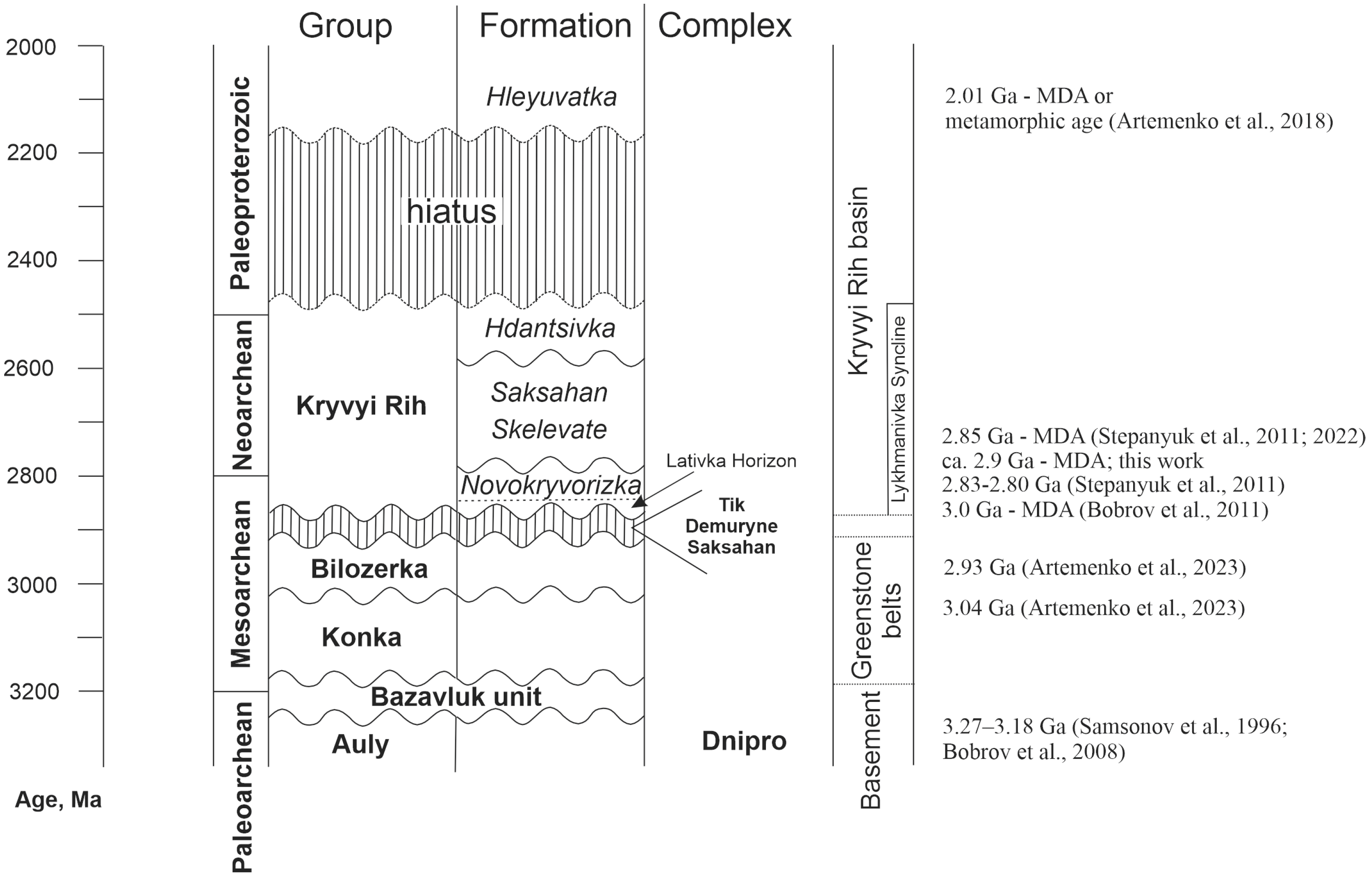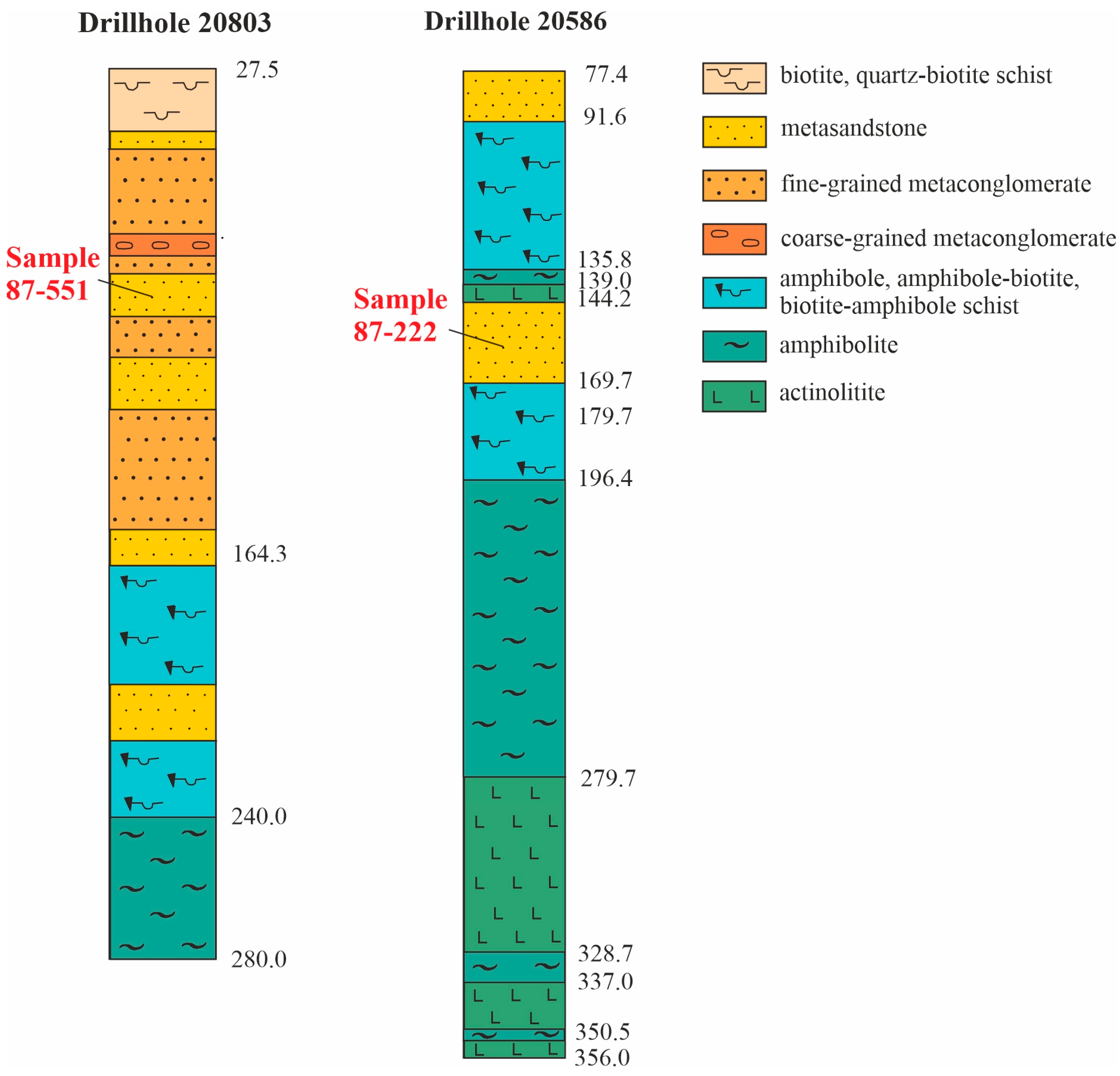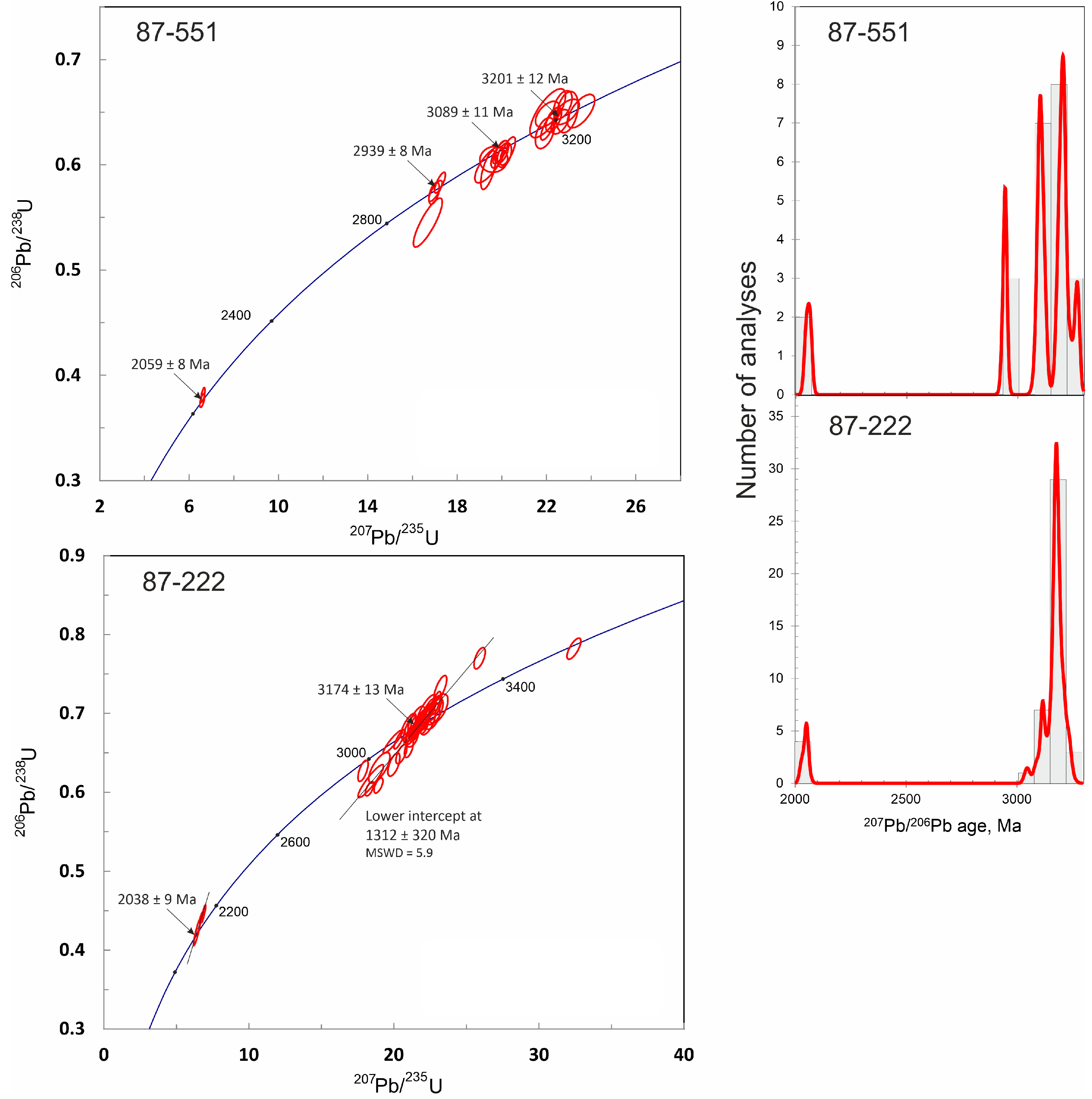The Relationships between Greenstone Belts and the Kryvyi Rih–Kremenchuk Basin in the Middle Dnieper Domain of the Ukrainian Shield Revealed by Detrital Zircon
Abstract
:1. Introduction
- -
- The lowermost Novokryvorizka Formation comprises metabasalts, amphibole schists, metaconglomerates, and metasandstones.
- -
- The Skelevate Formation comprises metaterrigenous rocks (sandstones, conglomerates, schists) and a horizon of talc-rich schists. The thickness of the formation is up to 300 m.
- -
- The Saksahan Formation is 650–800 m thick and represents the main productive BIF unit. It is composed of BIFs, separated by several horizons of schists and barren quartzites.
- -
- The Hdantsivka Formation, up to 1100 m thick, is composed of schists, marbles, dolostones, sandstones, and ferruginous–siliceous rocks (BIFs). It rests disconformably on the Saksahan Formation.


2. Geological Structure of the Studied Area
3. Studied Samples
4. Research Methods
5. Results
6. Discussion
6.1. Sources of the Archean Detrital Zircons
6.2. The Maximum Depositional Age and Origin of the Paleoproterozoic Zircon
6.3. Variations in the Provenance of the Sediments in the Kryvyi Rih–Kremenchuk Basin
6.4. Relationships between the Kryvyi Rih–Kremenchuk Basin and Greenstone Belts
7. Conclusions
Supplementary Materials
Author Contributions
Funding
Data Availability Statement
Acknowledgments
Conflicts of Interest
References
- Bekker, A.; Slack, J.F.; Planavsky, N.J.; Krapež, B.; Hofmann, A.; Konhauser, K.O.; Rouxel, O.J. Iron formation: The sedimentary product of a complex interplay among mantle, tectonic, oceanic, and biospheric processes. Econ. Geol. 2010, 105, 467–508. [Google Scholar] [CrossRef]
- Bekker, A.; Planavsky, N.J.; Krapež, B.; Rasmussen, B.; Hofmann, A.; Slack, J.F.; Rouxel, O.J.; Konhauser, K.O. Iron formations: Their origins and implications for ancient seawater chemistry. In Treatise on Geochemistry, 2nd ed.; Holland, H.D., Turekian, K.K., Eds.; Elsevier: Amsterdam, The Netherlands, 2014; Volume 9, pp. 561–628. [Google Scholar] [CrossRef]
- Isley, A.E.; Abbott, D.H. Plume-related mafic volcanism and the deposition of banded iron formation. J. Geophys. Res. 1999, 104, 15461–15477. [Google Scholar] [CrossRef]
- Sukach, V.V. The Mesoarchean greenstone structures of the Middle Dnieper Domain of the Ukrainian Shield: Stratigraphic sections, composition and age correlation. Mineral. J. 2014, 36, 77–91. (In Russian) [Google Scholar]
- Artemenko, G.V.; Shumlyanskyy, L.V.; Hoffmann, A.; Wilde, S.A.; Bekker, A. U-Pb age and Hf isotope systematics of zircons from rocks of the Bilozerka Greenstone Belt, the Middle Dnieper Domain of the Ukrainian Shield. In Proceedings of the 6th International Archean Symposium, Perth, Australia, 25–27 July 2023; Geol. Survey Western Australia, Record 2023/8. p. 4. [Google Scholar]
- Zheng, J.P.; Griffin, W.L.; Li, L.S.; O’Reilly, S.Y.; Pearson, N.J.; Tang, H.Y.; Liu, G.L.; Zhao, J.H.; Yu, C.M.; Su, Y.P. Highly evolved Archean basement beneath the western Cathaysia Block, South China. Geoch. Cosmoch. Acta 2011, 75, 242–255. [Google Scholar] [CrossRef]
- Hodych, J.P.; Cox, R.A.; Košler, J. An equatorial Laurentia at 550 Ma confirmed by Grenvillian inherited zircons dated by LAM ICP-MS in the Skinner Cove volcanics of western Newfoundland: Implications for inertial interchange true polar wander. Precam. Res. 2004, 129, 93–113. [Google Scholar] [CrossRef]
- Shumlyanskyy, L.; Nosova, A.; Billstrom, K.; Soderlund, U.; Andreasson, P.-G.; Kuzmenkova, O. The U-Pb zircon and baddeleyite ages of the Neoproterozoic Volyn Large Igneous Province: Implication for the age of the magmatism and the nature of a crustal contaminant. GFF 2016, 138, 17–30. [Google Scholar] [CrossRef]
- Yesypchuk, K.Y.; Bobrov, O.B.; Stepanyuk, L.M.; Shcherbak, M.P.; Hlevaskiy, E.B.; Skobelev, V.M.; Drannik, A.S.; Heichenko, M.V. Correlation Chronostratigraphic Chart of the Early Precambrian of the Ukrainian Shield (Explanatory Note); UkrDGRI Publisher: Kyiv, Ukraine, 2004; pp. 1–30. (In Ukrainian) [Google Scholar]
- Bobrov, O.B.; Stepanyuk, L.M.; Paranko, I.S.; Ponomarenko, O.M.; Shumlyanskyy, L.V.; Dhuime, B. Origin of zircon from the “Lativka” Horizon of the Kryvyi Rih Group of the Ukrainian Shield. Mineral. J. 2011, 33, 30–40. (In Ukrainian) [Google Scholar]
- Stepanyuk, L.M.; Bobrov, O.B.; Paranko, I.S.; Ponomarenko, O.M.; Sergeev, S.A. Genesis and age of zircon from amphibolite of the Novokryvorizka Formation of the Kryvyi Rih Basin. Mineral. J. 2011, 33, 69–76. (In Ukrainian) [Google Scholar]
- Stepanyuk, L.M.; Paranko, I.S.; Ponomarenko, O.M.; Dovbush, T.I.; Vysotskyi, O.B. The U-Pb age of detrital monazite from metasandstone of the Skelevate Formation of the Kryvyi Rih Basin. Mineral. J. 2011, 33, 80–89. (In Ukrainian) [Google Scholar]
- Stepanyuk, L.M.; Shumlyanskyy, L.V.; Hoffmann, A.; Hofmann, M.; Kovalick, A.; Bekker, A. On the Mesoarchean age of detrital zircon from metaterrigenous rocks of the Skelevate and Saksahan Formation of the Kryvyi Rih Basin (according to U-Pb dating results). Mineral. J. 2020, 42, 46–62. (In Ukrainian) [Google Scholar] [CrossRef]
- Artemenko, G.V.; Shumlyanskyy, L.V.; Bekker, A.Y.; Samborska, I.A.; Martynyuk, A.V.; Hoholev, K.I. The age of detrital zircon from quartzite of the East Hannivka belt. Mineral. J. 2015, 37, 86–94. (In Russian) [Google Scholar] [CrossRef]
- Artemenko, G.V.; Shumlyanskyy, L.V.; Hoffmann, A.; Bekker, A.Y. The age of rocks in the source area of quartzite of the Rodionivka Formation of the Inhul-Inhulets Group (Zhovte area of the Pravoberezhny region). Proceed. NAS Ukraine 2019, 12, 65–74. (In Russian) [Google Scholar] [CrossRef]
- Paranko, I.S. The place of the Kryvyi Rih and Bilozerka iron-bearing sections in the structural and formational complexes of the Ukrainian Shield. Proc. Lviv. Uni. Series Geol. 2010, 24, 8–14. (In Ukrainian) [Google Scholar]
- Shcherbak, N.P.; Polovko, N.I.; Levkovskaya, N.Y. The isotopic age of accessory minerals of the lower formation of the Kryvyi Rih Group. Geol. J. 1969, 29, 21–29. (In Russian) [Google Scholar]
- Kyrylyuk, V.P. Tectonic Map of Ukraine. Scale 1:1,000,000. Part II. Tectonic Map of the Basement of the Ukrainian Shield. Scale 1:2,000,000. With Explanatory Note; UkrSGEI Publisher: Kyiv, Ukraine, 2007; pp. 1–78. (In Ukrainian) [Google Scholar]
- Artemenko, G.V.; Shumlyanskyy, L.V.; Bekker, A.Y. The U-Pb age (LA-ICP-MS) of detrital zircon from the Hleyuvatka Formation of the Kryvbas, the Ukrainian Shield. Geol. J. 2018, 2, 42–57. (In Russian) [Google Scholar] [CrossRef]
- Samsonov, A.V.; Chernyshev, I.V.; Nutman, A.P.; Compston, W. Evolution of the Archaean Aulian Gneiss Complex, Middle Dnieper gneiss-greenstone terrain, Ukrainian Shield: SHRIMP U-Pb zircon evidence. Precam. Res. 1996, 78, 65–78. [Google Scholar] [CrossRef]
- Bobrov, O.B.; Stepanyuk, L.M.; Sergeev, S.A.; Presniakov, S.L. Metatonalite of the Dnipro Complex and the age stages of their formation (geological setting, composition and results of the SHRIMP dating). Proc. Ukr. State Geol. Inst. 2008, 1, 9–24. (In Ukrainian) [Google Scholar]
- Kalyaev, G.I. The Precambrian Tectonics of the Ukrainian Iron Ore Province; Naukova Dumka: Kyiv, Ukraine, 1965; pp. 1–190. (In Russian) [Google Scholar]
- Bobrov, O.B. New data on the age of deposits of the Bilozerka Formation (Middle Dnieper Domain). Geol. J. 1993, 53, 73–79. (In Russian) [Google Scholar]
- Bordunov, I.N. Kryvyi Rih—Kursk Eugeosyncline; Naukova dumka: Kyiv, Ukraine, 1983; pp. 1–304. (In Russian) [Google Scholar]
- Zmiivskyi, G.E.; Martynyuk, A.V. The Geological Structure and Geodynamics of the Tik Area: Report of the Prospecting-Survey Team on the Results of Deep Geological Mapping at a Scale of 1:50,000 within Sheets L-36-8-B, G (Southern Halves), L-36-20-A, B, Conducted in 1989–1993; Pivdenukrgeologiya: Dnipro, Ukraine, 1994. (In Russian) [Google Scholar]
- Akimenko, N.M.; Belevtsev, Y.N.; Horoshnikov, B.I.; Dubinkina, R.P.; Ishchenko, D.I.; Karshenbaum, A.P.; Kulishov, M.P.; Lyashchenko, K.P.; Maksimovich, V.L.; Siroshtan, R.I.; et al. Geological Structure and Iron Ores of the Kryvyi Rih Basin; Gosgeoltekhizdat: Moscow, Russia, 1957; pp. 1–278. (In Russian) [Google Scholar]
- Paranko, I.S.; Kholodilin, V.V. Gold Prospecting in Ancient Conglomerates of the Kryvyi Rih Basin (1984–1990). Prospecting Report: Kryvyi Rih, Ukraine, 1990. (In Russian) [Google Scholar]
- Zmiivskyi, G.E.; Paranko, I.S.; Zolotareva, L.I. A Comprehensive Geological Study of the Drilling Area of the Kryvyi Rig Superdeep Drill Hole (Second Stage, GIP 2). Prospecting-Survey team of the Kryvyi Rih State Geological Enterprise: Kryvyi Rih, Ukraine, 1990. (In Russian) [Google Scholar]
- Paton, C.; Hellstrom, J.; Paul, B.; Woodhead, J.; Hergt, J. Iolite: Freeware for the visualisation and processing of mass spectrometric data. J. Anal. At. Spectrom. 2011, 26, 2508–2518. [Google Scholar] [CrossRef]
- Petrus, J.A.; Kamber, B.S. Vizual Age: A novel approach to laser ablation ICP-MS U-Pb geochronology data reduction. Geostan. Geoanal. Res. 2012, 36, 247–270. [Google Scholar] [CrossRef]
- Wiedenbeck, M.; Alle, P.; Corfu, F.; Griffin, W.L.; Meier, M.; Oberli, F.; Von Quadt, A.; Roddick, J.C.; Spiegel, W. Three natural zircon standards for U-Th-Pb, Lu-Hf, trace element and REE analysis. Geostand. Newslett. 1995, 19, 1–23. [Google Scholar] [CrossRef]
- Wiedenbeck, M.; Hanchar, J.M.; Peck, W.H.; Sylvester, P.; Valley, J.; Whitehouse, M.; Kronz, A.; Morishita, Y.; Nasdala, L.; Fiebig, J.; et al. Further characterisation of the 91,500 zircon crystal. Geostand. Geoanal. Res. 2004, 28, 9–39. [Google Scholar] [CrossRef]
- Sláma, J.; Košler, J.; Condon, D.J.; Crowley, J.L.; Gerde, A.; Hanchar, J.M.; Horstwood, M.S.; Morris, G.A.; Nasdala, L.; Norberg, N. Plešovice zircon—A new natural reference material for U-Pb and Hf isotopic microanalysis. Chem. Geol. 2008, 249, 1–35. [Google Scholar] [CrossRef]
- Pointon, M.A.; Chew, D.M.; Ovtcharova, M.; Sevastopulo, G.D.; Crowley, O.G. New high-precision U-Pb dates from western European Carboniferous tuffs; implications for time scale calibration, the periodicity of late Carboniferous cycles and stratigraphical correlation. J. Geol. Soc. 2012, 169, 713–721. [Google Scholar] [CrossRef]
- Ludwig, K.R. Isoplot v.4.15: A geochronological toolkit for Microsoft Excel. Berkeley Geochron. Center Spec. Publ. 2011, 4, 1–75. [Google Scholar]
- Woodhead, J.D.; Hergt, J.M. A preliminary appraisal of seven natural zircon reference materials for in situ Hf isotope determination. Geostand. Geoanal. Res. 2005, 29, 183–195. [Google Scholar] [CrossRef]
- Woodhead, J.; Hergt, J.; Shelley, M.; Eggins, S.; Kemp, R. Zircon Hf-isotope analysis with an excimer laser, depth profiling, ablation of complex geometries, and concomitant age estimation. Chem. Geol. 2004, 209, 121–135. [Google Scholar] [CrossRef]
- Söderlund, U.; Patchett, P.J.; Vervoort, J.D.; Isachsen, C.E. The 176Lu decay constant determined by Lu–Hf and U–Pb isotope systematics of Precambrian mafic intrusions. Earth Planet. Sci. Lett. 2004, 219, 311–324. [Google Scholar] [CrossRef]
- Bouvier, A.; Vervoort, J.D.; Patchett, P.J. The Lu–Hf and Sm–Nd isotopic composition of CHUR: Constraints from unequilibrated chondrites and implications for the bulk composition of terrestrial planets. Earth Planet. Sci. Lett. 2008, 273, 48–57. [Google Scholar] [CrossRef]
- Shcherbak, N.P.; Artemenko, G.V.; Lesnaya, I.M.; Ponomarenko, A.N. Geochronology of the Early Precambrian of the Ukrainian Shield (Archaean); Naukova Dumka: Kyiv, Ukraine, 2006; 244p. (In Russian) [Google Scholar]
- Samsonov, A.V.; Zhuravlev, D.Z.; Bibikova, E.V. Geochronology and petrogenesis of an Archaean felsic volcano-plutonic suite of the Verchovtseve greenstone belt, Ukrainian Shield. Int. Geol. Rev. 1993, 35, 1166–1181. [Google Scholar] [CrossRef]
- Artemenko, G.V.; Shumlyanskyy, L.V.; Chew, D.; Drakou, F.; Dudik, O.M. The age of sedimentary-volcanogenic rocks of the Chortomlyk iron deposit, the Middle Dnipro Domain of the Ukrainian Shield. Mineral. J. 2024, 46, 74–84. [Google Scholar] [CrossRef]
- Kemp, A.I.S.; Hawkesworth, C.J.; Paterson, B.A.; Kinny, P.D. Episodic growth of the Gondwana supercontinent from hafnium and oxygen isotopes in zircon. Nature 2006, 439, 580–583. [Google Scholar] [CrossRef] [PubMed]
- Hoskin, P.W.O.; Schaltegger, U. The composition of zircon and igneous and metamorphic petrogenesis. Rev. Mineral. Geochem. 2003, 53, 27–62. [Google Scholar] [CrossRef]
- Rubatto, D. Zircon: The metamorphic mineral. Rev. Mineral. Geochem. 2017, 83, 261–295. [Google Scholar] [CrossRef]
- Yakymchuk, C.; Kirkland, C.L.; Clark, C. Th/U ratios in metamorphic zircon. J. Metam. Geol. 2018, 36, 715–737. [Google Scholar] [CrossRef]
- Shumlyanskyy, L.V. The age and isotopic composition of hafnium in zircons from quartzite of the Middle Bouh area of the Ukrainian shield. Geochem. Ore Form. 2012, 31–32, 136–143. (In Ukrainian) [Google Scholar] [CrossRef]
- Kuper, K.M.; Armstrong, R.; Kirkland, C.L.; Olierook, H.K.H.; Clark, C.; Evans, K. Implications of high-grade metamorphism on detrital zircon data sets: A case study from the Fraser Zone, Western Australia. Chem. Geol. 2024, 647, 121918. [Google Scholar] [CrossRef]
- Stepanyuk, L.M.; Shumlyanskyy, L.V.; Ponomarenko, O.M.; Dovbush, T.I.; Vysotskyi, O.B.; Dhuime, B. On the age limits of the Kosharo-Oleksandrivka Formation of the Bouh Group in the Bouh area. Geochem. Ore Form. 2010, 28, 4–10. (In Ukrainian) [Google Scholar]
- Shumlyanskyy, L.; Wilde, S.A.; Nemchin, A.A.; Claesson, S.; Billström, K.; Bagiński, B. Eoarchean rock association in the Dniester-Bouh Domain of the Ukrainian shield: A suite of LILE-depleted enderbites and mafic granulites. Precam. Res. 2021, 352, 106001. [Google Scholar] [CrossRef]
- Moreira, H.; Dhuime, B.; Ionov, D.; Buzenchi, A.; Gusev, N. Hafnium isotope systematics of zircon in high-grade metamorphic rocks of the Anabar Shield, Siberia: Radiogenic Hf without mantle input? Chem. Geol. 2023, 636, 121644. [Google Scholar] [CrossRef]
- Shumlyanskyy, L.V. Petrology and Geochronology of Rock Complexes of the North-Western Region of the Ukrainian Shield and Its Western Slope. Ph.D. Thesis, M.P. Semenenko Institute of Geochemistry, Mineralogy and Ore Formation, Kyiv, Ukraine, 2012; 463p. (In Ukrainian). [Google Scholar]
- Stepanyuk, L.M.; Shumlyanskyy, L.V.; Kurylo, S.I.; Syomka, V.O.; Bondarenko, S.M.; Wilde, S.A.; Nemchin, A.A. The U-Pb geochronology (LA-ICP-MS) of geological processes in granulites of the Middle Bouh area. Paper 3. Rock association of the lower reaches of the Yatran river. Mineral. J. 2021, 43, 34–50. (In Ukrainian) [Google Scholar] [CrossRef]
- Reshetnyk, M.; Zaiats, O.; Shumlyanskyy, L.; Starokadomsky, D.; Stepanyuk, L. Geochronology and origin of Paleoproterozoic charnockites with old crustal signature in the Haisyn block of the Ukrainian shield. Acta Geochim. 2023, 42, 393–408. [Google Scholar] [CrossRef]
- Stepanyuk, L.M.; Dovbush, I.M.; Kurylo, S.I.; Lisna, I.M.; Petrychenko, K.V. The final stage of granitoid magmatism in the Dniester-Bouh Domain of the Ukrainian Shield. Geochem. Ore Form. 2016, 36, 72–81. (In Ukrainian) [Google Scholar] [CrossRef]
- Artemenko, G.V.; Samborska, I.A.; Shvaika, I.A.; Hoholev, K.I.; Dovbush, T.I. Stages of the Paleoproterozoic collision granitoid magmatism and metamorphism in the Azov and Middle Dnieper Domains of the Ukrainian Shield. Mineral. J. 2018, 40, 45–62. (In Russian) [Google Scholar] [CrossRef]
- Shumlyanskyy, L.V.; Stepanyuk, L.M.; Claesson, S.; Rudenko, K.V.; Bekker, A.Y. U-Pb on zircon and monazite geochronology of granitoids of the Zhytomyr and Sheremetiv complexes, the Northwestern region of the Ukrainian Shield. Mineral. J. 2018, 40, 63–85. (In Ukrainian) [Google Scholar] [CrossRef]
- Artemenko, G.V.; Shumlyanskyy, L.V.; Wilde, S.A. The lower age boundary of the formation of metaterrigenous rocks of the Vysokopillya greenstone structure, the Middle Dnieper Domain of the Ukrainian Shield. Geol. J. 2020, 2, 3–17. (In Russian) [Google Scholar] [CrossRef]
- Condie, K.C. Archean Greenstone Belts. In Development in Precambrian Geology, 3rd ed.; Elsevier: Amsterdam, The Netherlands, 1981; 434p. [Google Scholar]
- Anhaeusser, C.R. Archaean greenstone belts and associated granitic rocks—A review. J. Afr. Earth Sci. 2014, 100, 684–732. [Google Scholar] [CrossRef]
- Smithies, R.H.; Ivanic, T.J.; Lowrey, J.R.; Morris, P.A.; Barnes, S.J.; Wyche, S.; Lu, Y.J. Two distinct origins for Archean greenstone belts. Earth Planet. Sci. Lett. 2018, 487, 106–116. [Google Scholar] [CrossRef]
- Shcherbak, N.P.; Artemenko, G.V.; Ponomarenko, A.N. Geochronological stages of the formation of greenstone associations in the Middle Dnieper and Karelia cratons and greenstone belts of the Voronizh massif in the East-European platform. Mineral. J. 2009, 31, 3–19. (In Russian) [Google Scholar]
- Claesson, S.; Artemenko, G.; Bogdanova, S.; Shumlyanskyy, L. Archean crustal evolution in the Ukrainian shield. In Earth’s Oldest Rocks, 2nd ed.; van Kranendonk, M.J., Bennett, V., Hoffmann, E., Eds.; Elsevier: Amsterdam, The Netherlands, 2019; pp. 837–854. [Google Scholar]
- Artemenko, G.V.; Shumlyanskyy, L.V.; Chew, D.; Drakou, F.; Dhuime, B.; Moreira, H. The U-Pb age and Hf isotope composition of zircon from metaandesite of the Chortomlyk Formation and rhyodacite of the hypabbysal intrusion of the Sura Complex, Chortomlyk greenstone belt. Geol. J. 2024, 2, 3–17. (In Ukrainian) [Google Scholar] [CrossRef]
- Ponomarenko, A.N.; Lesnaya, I.M.; Zyultsle, O.V.; Gatsenko, V.A.; Dovbush, T.I.; Kanunikova, L.I.; Shumlyanskyy, L.V. Neoarchean of the Ros-Tikych Domain of the Ukrainian Shield. Geochem. Ore Form. 2010, 28, 11–16. (In Russian) [Google Scholar]
- Bibikova, E.V.; Claesson, S.; Fedotova, A.A.; Stepanyuk, L.M.; Shumlyanskyy, L.V.; Kirnozova, T.I.; Fugzan, M.M.; Ilinsky, L.S. Isotope geochronological (U–Th–Pb, Lu–Hf) study of the zircons from the Archean magmatic and metasedimentary rocks of the Podolia Domain, Ukrainian Shield. Geochem. Int. 2013, 51, 87–108. [Google Scholar] [CrossRef]
- Stepanyuk, L.M.; Kurylo, S.I. Geochemistry of Two-Feldspar Granitoids of the Middle Dnieper Domain; Naukova Dumka Publisher: Kyiv, Ukraine, 2019; 207p. (In Ukrainian) [Google Scholar]
- Lesnaya, I.M. Geochronology of Charnockites of the Bouh Area; Naukova Dumka Publisher: Kyiv, Ukraine, 1988; 13p. (In Russian) [Google Scholar]
- Viehmann, S.; Bau, M.; Hoffmann, J.E.; Münker, C. Geochemistry of the Krivoy Rog Banded Iron Formation, Ukraine, and the impact of peak episodes of increased global magmatic activity on the trace element composition of Precambrian seawater. Precam. Res. 2015, 270, 165–180. [Google Scholar] [CrossRef]




Disclaimer/Publisher’s Note: The statements, opinions and data contained in all publications are solely those of the individual author(s) and contributor(s) and not of MDPI and/or the editor(s). MDPI and/or the editor(s) disclaim responsibility for any injury to people or property resulting from any ideas, methods, instructions or products referred to in the content. |
© 2024 by the authors. Licensee MDPI, Basel, Switzerland. This article is an open access article distributed under the terms and conditions of the Creative Commons Attribution (CC BY) license (https://creativecommons.org/licenses/by/4.0/).
Share and Cite
Artemenko, H.; Shumlyanskyy, L.; Chew, D.; Drakou, F.; Dhuime, B.; Moreira, H.; Butyrin, V. The Relationships between Greenstone Belts and the Kryvyi Rih–Kremenchuk Basin in the Middle Dnieper Domain of the Ukrainian Shield Revealed by Detrital Zircon. Geosciences 2024, 14, 254. https://doi.org/10.3390/geosciences14100254
Artemenko H, Shumlyanskyy L, Chew D, Drakou F, Dhuime B, Moreira H, Butyrin V. The Relationships between Greenstone Belts and the Kryvyi Rih–Kremenchuk Basin in the Middle Dnieper Domain of the Ukrainian Shield Revealed by Detrital Zircon. Geosciences. 2024; 14(10):254. https://doi.org/10.3390/geosciences14100254
Chicago/Turabian StyleArtemenko, Hennadii, Leonid Shumlyanskyy, David Chew, Foteini Drakou, Bruno Dhuime, Hugo Moreira, and Valeryi Butyrin. 2024. "The Relationships between Greenstone Belts and the Kryvyi Rih–Kremenchuk Basin in the Middle Dnieper Domain of the Ukrainian Shield Revealed by Detrital Zircon" Geosciences 14, no. 10: 254. https://doi.org/10.3390/geosciences14100254





